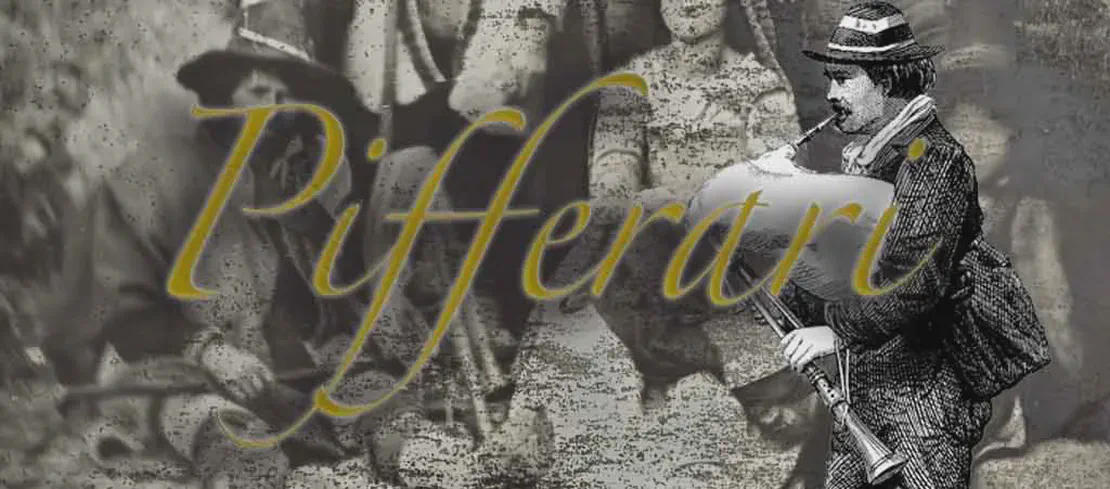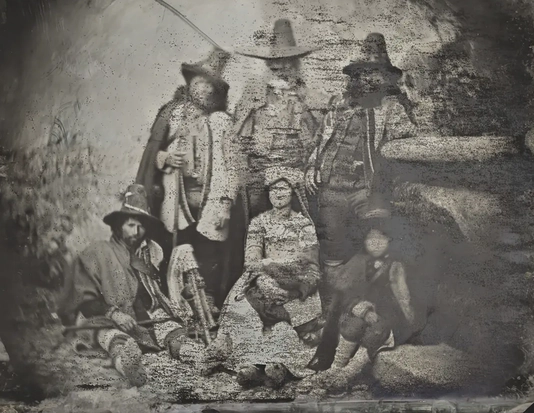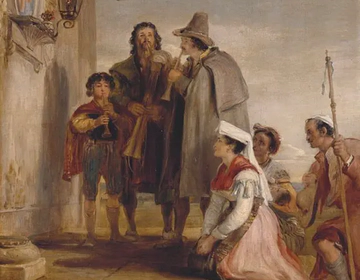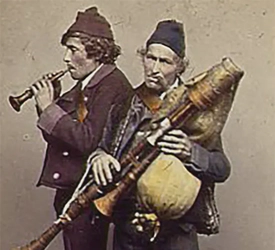
In Spring 1842, a Wealthy Scholar and Artist, named Joseph Girault De Prangey, left his native France to embark on a grand tour of the Orient.
He was passionate about archeology and Islamic architecture and planned to make a series of Publications about the sites he visited. In order to document them as truthfully and efficiently as possible he brought with hime a brand new tool, the camera. The camera was made available to the public in 1839 with the introduciton of the integario type process
1842 Photo of Pifferari

His journey took him from Italy to Greece, Eygpt to Turkey, to the Levant he captured over 1,000 photographs with subjects ranging from streetscapes and Architectural details to nature, landscapes and protraits of local people.
During his time in Italy, which at the time was not a unified country but a collection of sovergeign countries. While in Rome, he photographhed the Pifferari, herders who came down from the surrounding mountains each Christmas to play their ancient songs at wayside shrines to the Madonna.
Pifferari

The Pifferari (singular: Pifferaro) were itinerant musicians from the mountainous areas of Abruzzo, Ciociaria, and other parts of central and southern Italy, particularly noted during the 19th century and possibly earlier.
They were known for playing the piffero, a traditional wooden folk instrument similar to an oboe, accompanied by other instruments like the zampogna, a type of large Italian bagpipe. The Pifferari typically performed folk melodies and religious hymns, especially around Christmas time when they often traveled to Rome and other cities to play in front of churches and religious shrines as part of seasonal celebrations.
Their music and presence in urban areas during the holiday season were emblematic of rural Italian culture and traditions, providing a stark contrast to the urban settings in which they performed. The Pifferari dressed in picturesque traditional clothing, contributing to their distinctive appearance and making them a subject of interest and romanticization among city dwellers and artists alike. They were often depicted in 19th-century Italian art and literature, symbolizing a rustic and devout way of life that was becoming increasingly overshadowed by industrialization and urbanization.
Over time, the tradition of the Pifferari has waned, largely due to socio-economic changes in Italy that have reduced the itinerant way of life and the practice of seasonal migration for work or performance. However, their legacy continues to be celebrated in Italian culture as part of the country’s rich folk heritage, with their music and iconic image still evoked in discussions of Italian Christmas traditions and rural history.
Zampogna - Italian Bagpipes

The zampogna is a traditional Italian bagpipe, which has been a significant part of Italy’s folk music tradition, especially in the southern regions such as Abruzzo, Calabria, Campania, and Sicily, as well as in central areas like Lazio. Characterized by its distinctive sound and complex construction, the zampogna is closely associated with pastoral culture ansd is traditionally played during Christmas and other religious festivals.
The instrument consists of several pipes of varying lengths that produce different pitches. Typically, it includes two chanters (melody pipes) and two or more drones (which produce a continuous harmonic background note). The chanters often are played with both hands and can produce a harmonious sound that is richer and more varied than many other types of bagpipes. The zampogna is made from various materials, including wood for the pipes and leather or synthetic materials for the bag, which is inflated either by mouth or through a bellows operated by the elbow.
The playing of the zampogna is closely linked to pastoral life and seasonal agricultural cycles, reflecting themes of birth, death, and renewal that are central to rural and agricultural communities. It is particularly associated with the Christmas season, where zampogna players, often accompanied by a piffero (a type of double-reed oboe), would perform traditional Christmas music and carols in towns and villages, a practice reminiscent of the shepherds celebrating the birth of Christ.
Despite its strong association with traditional and rural contexts, the zampogna has experienced a revival in recent years, with increased interest in folk music traditions and cultural heritage. This has led to a renewed appreciation for the instrument, its music, and its role in Italian cultural history, with contemporary musicians exploring both traditional repertoire and new compositions for the zampogna.
View Photo at 7:06s
- Bagpiper